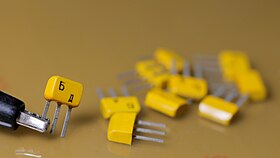This article has multiple issues. Please help improve it or discuss these issues on the talk page. (Learn how and when to remove these messages)
|

| |
| КТ315 А...И | |
|---|---|
| Structure | n-p-n |
| Uce | 15–60 V |
| Ube | 6 V |
| Ic | 50–100 mA |
| Ib | 50 mA |
| P | 100 mW |
| Pmax | 150 mW |
| Tmax, °C | up to 100 °C |
| fT | 250 MHz |
| h21e | 20–350 |

The KT315 is a Soviet silicon NPN bipolar junction transistor used for general-purpose low-power amplifying or switching applications, enclosed in the plastic KT-13 package. It was widely used in Soviet electronic equipment. The KT361 is a complementary (PNP) for the KT315 transistor, so it was often paired with it in push-pull stages.
KT315 and KT361 transistors became the first in the USSR, which were produced using planar technology. The characteristics achieved in the KT315 were groundbreaking in Soviet technology at that time. The process of manufacturing was much cheaper than the alloy-junction technology, and the parameters surpassed those of earlier transistor types, in particular, the unity-gain frequency was 250 MHz.
The people associated with the development and mass-production launch of the KT315 were awarded the USSR State Prize for it in 1973.
Application
KT315 transistors were designed for use in high-, medium- and sound-frequency amplifying stages.
See also
- 2N3904 — NPN transistor with slightly better specifications than KT315. Usually can be used as a replacement.
- 2N3906 — PNP transistor with slightly better specifications than KT361. Usually can be used as a replacement.
- Bipolar junction transistor
References
- Национальная академия наук Беларуси :: Член-корреспондент ОНЕГИН Евгений Евгеньевич (1932-2002) (in Russian). Archived from the original on 8 August 2011. Retrieved 17 May 2015.
- Музей электронных раритетов - Актив - КТ315+КТ361 (in Russian). Retrieved 28 May 2015.
External links
- Reference data and pinout (in Russian)
- Crustall photos (in Russian)
This electronics-related article is a stub. You can help Misplaced Pages by expanding it. |